Numerical simulation of electroosmosis in unsaturated compacted clay
KangWei Tang ,Feng Zhang ,DeCheng Feng ,GuanFu Wang
School of Transportation Science and Engineering,Harbin Institute of Technology,73 Huanghe Road,Harbin,Heilongjiang 150090,China
ABSTRACT The moisture content of a road subgrade in cold regions will increase after freeze-thaw cycles,resulting in subgrade strength and stiffness losses.Electroosmosis is widely used in treating saturated soft soils to decrease the moisture content.The induced moisture migration during electroosmosis in unsaturated soil is much more complex than that of saturated soil because of a series of nonlinear changes in soil properties.This study first uses an exponential function to characterize the relationship between electroosmotic permeability and saturation degree.Then,a one-dimensional model is developed to simulate the electroosmosis-induced moisture migration in unsaturated soil.Simulation results show that electroosmosis reduces the saturation degree of the unsaturated soil,indicating that it can be applied to subgrade dewatering.Key parame‐ters such as soil pore size distribution coefficient,air entry value,and effective voltage significantly affect moisture migra‐tion.Electroosmotic properties of unsaturated soils are extremely important to the efficiency of electroosmosis.
Keywords:electro-osmosis;unsaturated clay;moisture migration;numerical simulation
1 Introduction
Moisture migration induced by freeze-thaw cycles in seasonal frost areas would result in increased soil moisture contents,leading to a reduction in both stiff‐ness and shear strength.It has been reported that an increase of moisture content by 8%causes a 90%re‐duction in resilient modulus(Kohoury et al.,2012)and a 50%reduction in pavement service life(Arika et al.,2009).Therefore,maintaining the moisture con‐tent at its optimum value is critical to ensure the sub‐grade's functionality and serviceability during its ser‐vice life.Various drainage systems are commonly used in road engineering,including traditional side ditch,drainage ditch,waterproof cushion,and novel bio-wicking approach(Lin and Zhang,2018).
Electro-osmosis is also a potential technique to de‐water subgrade.Electro-osmosis was firstly applied by Casagrande(1949)in an excavation of a railway subgrade.Laboratory experiments and field tests showed that electroosmosis could reduce soil mois‐ture content and increase soil strength(Morris,1985;Lo,1991;Schultz,1997).After that,it became a wide‐ly used technique for improvement of soft soils(Chew,2004;Ou,2009;Karunaratne,2011),dewater‐ing of tailings and sludge(Fourie,2010;Mahmoud,2016;Wang,2018),remediation of contaminated soils(Murdoch,1997;Lima,2011,2012),and stabilization of dikes and slopes(Wittle,2008;Black,2016).
The Helmholtz-Smoluchowski model developed by Helmholtz(1879)and modified by Smoluchowski(1921)was the first one describing the flow process of electroosmosis.The improved Helmholtz equations proposed by Freundlich(1926)provided a method of calculating electroosmosis flows through a prism of saturated soil.Electroosmotic permeability is a con‐stant dependent on the pore area but independent of pore sizes.Based on the above researches,Esrig(1968)first proposed a one-dimensional(1D)theory of consolidation to predict pore-water pressure devel‐opment.The theory assumed that the driving force for fluid flows could be electric current and/or water head loss,and superimposition law was valid.More realis‐tic models,such as two-dimensional models(2D)and three-dimensional models(3D),were developed by considering more complex boundary and initial condi‐tions(Su and Wang,2003;Hu and Wu,2014;Zhou and Deng,2019).Electro-osmosis was often com‐bined with other methods such as direct loading,vacu‐um preloading,and linear loading in practical engi‐neering(Wan and Mitchell,1976;Shang,1998),and corresponding models have also been established.
Soil properties,including hydraulic permeability,electroosmotic permeability,compressibility,specific conductance,and electrokinetic mobility,would change due to the large strain of soil mass.Yuan and Hicks(2013)demonstrated the importance of consid‐ering large strain and proposed a series of models with nonlinear hydraulic and electroosmotic permea‐bilities(Yuan and Hicks,2016a,2016b).Hu et al.(2012)proposed a physical-based model to determine the magnitude of electroosmosis-induced consolida‐tion considering nonlinearities in soil mechanical and electrical properties.Similarly,the finite difference model EC1 proposed by Zhou et al.(2013)and EC2 proposed by Deng and Zhou(2016)also accounted for nonlinear changes of the physical and electrochemical properties induced by large strain.Laborato‐ry experimental results showed that nonlinear varia‐tions in soil properties had remarkable impacts on ex‐cess pore water pressure and degree of consolidation.Then,Wu et al.(2016,2017)incorporated nonlineari‐ties in soil compressibility and hydraulic/electroos‐motic permeability in a 1D model to account for these effects.Wang et al.(2020)indicated that the average negative pore water pressure under combined electro‐osmosis and vacuum-surcharge preloading was larger considering the changes in nonlinear soil properties,leading to a faster consolidation rate.Considering the change of electric f low in electroosmosis,Lewis and Humpheson(1973)provided numerical analyses as‐suming a variable current.Shen et al.(2019)demon‐strated the nonlinear distribution of soil voltage and es‐tablished a more reasonable electroosmosis consolida‐tion model using a cubic polynomial-fitted voltage dis‐tribution.The layered soil heterogeneity was accounted for in an electroosmosis consolidation model of a twolayer soil profile developed by Zhao et al.(2020).
Most existing models were built for electroosmosis of saturated soil.However,electroosmosis often dewa‐ters soils and renders them unsaturated.Yuan(2016)developed a numerical model for elastoplastic electro‐osmosis consolidation of unsaturated clays.Zhou et al.(2019)proposed a numerical model for simulating the consolidation under electroosmosis-surcharge and pre‐loading considering varying degrees of soil saturation.Electroosmotic permeability of unsaturated soils is no longer a constant as saturated soils but would change with moisture content.Wang et al.(2019)developed an exponential function shaped-relationship between electroosmotic permeability and moisture content and revealed that the soil-water characteristics had a re‐markable impact on electroosmosis of unsaturated soil.
There are few studies on electroosmosis of unsatu‐rated soil with nonlinear variation of voltage,hydrau‐lic and electroosmotic permeability.This study devel‐ops one dimensional(1D)drainage model to simulate moisture migration within unsaturated soil under elec‐troosmosis.This model is based on Richards equa‐tion,the conservation of fluid mass and electric charge,and incorporates nonlinear soil properties and electric parameters.An exponential function repre‐sents the relationship between the electroosmotic per‐meability and moisture content of unsaturated soil.Variations of moisture content and drainage derived by this model are validated by laboratory tests.Final‐ly,the influences of soil properties and effective volt‐age on moisture migration within unsaturated soil un‐der electroosmosis are analyzed and discussed.
2 Numerical model for electroosmosis in unsaturated oil
2.1 Theoretical analysis
Soils used in this study are fine-grained,highly compacted,and unsaturated,and moisture migration was assumed to follow Darcy's law.The numerical model for electroosmosis in unsaturated soil was sup‐ported by the following assumptions:
(1)Soils are homogeneous.
(2)The hydraulic permeability,electroosmotic permeability,and electrical properties of soils are de‐pendent on moisture content.
(2)Soil grain and water are incompressible,and deformation of soil massis neglected.
(3)Moisture migration only occurs in the vertical direction.
(4)The fluid flows due to an electric field and hy‐draulic gradient may be linearly superimposed.
(5)Soils are unsaturated,and the water flow obeys Richard's equation.
Figure 1a depicts the configuration of electroos‐mosis in unsaturated soils.A voltage is applied be‐tween the anode(i.e.,the top surface)and the cathode(i.e.,the bottom surface).The top and bottom bound‐aries are permeable,while the lateral boundaries are impermeable.Moisture would migrate from top to bottom under hydraulic gradient and voltage.Figure 1b illustrates the moisture migration in a differential unit,in which vzis the velocity of moisture migrating into the unit along the Z-axis,representing the amount of moisture flow through a unit area per unit time;thus that migrating out of the unit is

Figure 1 One-dimensional model for electroosmosis in unsaturated soil:(a)configuration of electroosmosis;(b)moisture migration through a differential unit
The moisture migration velocity vzunder electroos‐mosis is the superposition of the velocities of hydrau‐lic and electroosmotic migration.The electroosmotic velocity in clay soils proposed by Helmholtz-Smo‐luchowski could be expressed as follows(Casa‐grande,1948):

where vedenotes electroosmotic velocity,kethe elec‐troosmosis conductivity,E the intensity of the electric field,D the dielectric constant,ξthe zeta potential,andηthe coefficient of viscosity of the liquid.
The equation for discharge velocity of water through soils published by Darcy(1856)could be ex‐pressed as:

where vhis the discharge velocity,khthe hydraulic per‐meability,and i the hydraulic gradient.
According to assumption(4)proposed by Esrig(1968),the water flow velocity in any directions in the soil during electroosmosis could be expressed by the following equation:

whereνis water flow velocity vector in total,νhis hy‐draulic flow velocity vector,νeis electroosmotic ve‐locity vector,H is the hydraulic head,φthe potential,and▽is Hamiltonian operator,shown as Formula(4):

According to assumption(5),the flow in unsatu‐rated soil obeys Richard's equation:

where hmis the matric suction head,kx(hm),ky(hm),kz(hm)are unsaturated hydraulic permeability coefficient functions.C(hm)is the specific water capacity and can be expressed as follows:

whereθis the volumetric moisture content.
Richards equation also can be expressed in terms of volume moisture content:

where kx(ψ(θ)),ky(ψ(θ)),kz(ψ(θ))are unsaturated hy‐draulic permeability coefficient functions,andψ(θ)is the matric suction function.
Formula(7)can be simplified into Formula(8)by introducing the Hamiltonian as shown in Formula(4)and replacing k(ψ(θ))with kh(θ):

where kh(θ)is the unsaturated hydraulic permeability coefficient function with moisture content as the variable.
Based on conservation of fluid mass and assump‐tions(4)and(5),combined Formula(3)and Formula(8),moisture governing equation of unsaturated soil under electroosmosis can be obtained as follows:

where ke(θ)is Electro-osmotic permeability function(in m/(s·V)).
The electric field governing equation according to Ohm's law is as follows:

where Cpis the capacitance of soil,approximately zero;φis potential(in V);t is time(in S);σeis soil conductiv‐ity(in S/m),is dependent on saturation of the soil,can be derived by the generalized Archie's formulas:

whereθis moisture content;θris residual moisture content;θsis saturated moisture content;A and B are regression parameters.
The governing equations of hydropower cou‐pling could be obtained according to Formula(9)and Formula(10):

2.2 Model parameters and boundary conditions
The relationship of hydraulic permeability of un‐saturated soil and saturation,according to Van Genu‐chten(1980),is as follow:

where Khand Ksare the hydraulic permeability of soil under unsaturated and saturated conditions,respec‐tively;m is the symmetry parameter of the soil-water characteristic curve.Seis the effective saturation and can be calculated by the following formula:

whereθis the volumetric moisture content of soil;θris residual moisture content;θsis saturated moisture content.The unsaturated hydraulic permeability coef‐ficient function with moisture content as the variable could be expressed by combining Formula(13)and Formula(14)as follows:

The electroosmotic conductivity of unsaturated soil is not constant and changes with moisture con‐tent.The relationship between electroosmotic permea‐bility and the matric suction adopted by Wang et al.(2019)was expressed by an exponential function as follows:

where Keis the electroosmotic permeability;Kesis the electroosmotic permeability at saturation;e is the nat‐ural constant;βis the relative electroosmotic permea‐bility exponent,i.e.,0.016;andθis moisture content.
In this study,a function similar to Formula(15)was built to express the relationship between the elec‐troosmotic permeability and moisture content:

where m2was introduced to evaluate the relative elec‐troosmotic permeability.
The soil-water characteristic curve proposed by Van Genuchten(1980)described the relationship of effective saturation and matric suction:

whereαis the reciprocal of air entry value,n is pore size distribution coefficient,and m is the symmetry parameter of the soil-water characteristic curve.The expression of matric suction can be obtained by Formula(19):

Based on the relationship between Seand θ described by Formula(18),the matric suction function with moisture contentθas a variable was obtained:
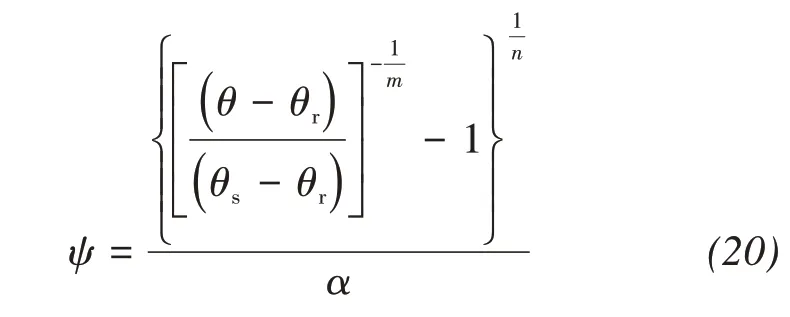
There are only two independent variables,includ‐ing the volumetric moisture contentθand potential U,in the governing equations,so the equations are solvable.
The top and bottom surfaces are Dirichlet bound‐aries,i.e.,free for water flow.In contrast,the lateral boundary is the zero flux boundary of water and elec‐tricity.Potential at the top surface varying with time is obtained by a laboratory test,and potential at the bottom surface is set to zero.The parameters applied in the model are as shown in Table 1.

Table 1 Geotechnical properties and calculation parameters of clay soil
3 Model validation
Most electroosmosis experiments were conducted on saturated soils.Hence there is little data available for validating the proposed numerical model.In this study,a laboratory test on unsaturated soil was per‐formed to provide data for verifying the model's capa‐bility of predicting moisture migration in unsaturated soil under electroosmosis.
Clay soil used in this test was sampled from Harbin,China.It is widely used as a subgrade fill‐er in Northeast China,and its geotechnical index properties and related parameters are listed in Table 2.

Table 2 Geotechnical properties and calculation parame‐ters of clay soil
A custom-made apparatus with 100 mm in diame‐ter and 200 mm in height,as shown in Figure 2,was used to conduct the moisture migration test of unsatu‐rated soil under electroosmosis.The soil was compact‐ed into the apparatus with a dry density of 1.38 g/cm3.After immersion treatment,the initial moisture con‐tent of the specimen reached about 45.0%and was nearly saturated.A DC power supply with an output capacity of 60 V and 5 A was applied between the electrodes.There were five volumetric moisture con‐tent sensors with a measurement range of 100%and accuracy of±3%inserted into the specimen along the vertical direction at 40 mm intervals.Two poten‐tial needles,i.e.,P1 and P2,were inserted into the specimen close to the anode and the cathode,respec‐tively,measuring the effective voltage applied to the specimen.
The electroosmosis was performed until the cur‐rent decreased to 10%of the initial current,and the entire process lasted 172 h.During the electroosmo‐sis,voltage and moisture content were monitored ev‐ery 0.5 h.The effective voltage monitored during elec‐troosmosis shown in Figure 3 could be expressed by the following equation:

Thus the potential boundary condition at the top surface was also determined.
Figure 4 presents the comparison of moisture con‐tent variation versus time from the experiment and numerical simulation by the proposed model.As shown in Figure 4,moisture contents at M1 through M5 all experienced similar changes:moisture con‐tents declined rapidly at first,slowed down,and fi‐nally stabilized.The final moisture contents at M1 through M5 were 27.0%,30.4%,29.9%,30.0%,and 31.1%,respectively.The final decrease in moisture content at M1 was the most significant,while those at M2 through M5 were almost the same;the aver‐age decrease was 16.3%.In general,the changing trend of moisture content by numerical simulations agrees with the observed.A shortcoming of the nu‐merical model is that its predicted moisture content maintains a decreasing trend,even towards the final stage,and the predicted values are 3%less than the measured ones at the end of the experiment.In other words,the model overestimates the effects of the method in reducing the soil's moisture content,espe‐cially after 50 hours.The primary reason is that the damage of the anode is not considered in the model.Observation of the electrodes after the test indicates that the anode is seriously damaged,reducing the ef‐ficiency of electroosmosis.If the electrode's durabili‐ty is improved,test results would be closer to the model prediction.Wang et al.(2019)found moisture content near the cathode fluctuated throughout the test due to the formation of a relatively impermeable soil layer above the porous stone.This phenomenon may help explain why moisture stopped migrating earlier than predicted by the numerical model.An‐other reasonable speculation is that some over-dried soil layers consumed most of the effective voltage so that there is less energy for electroosmosis.These over-dried layers can not be detected by moisture sensors that only reflect the average moisture con‐tent of the nearby soil but increase the soil resistance significantly.
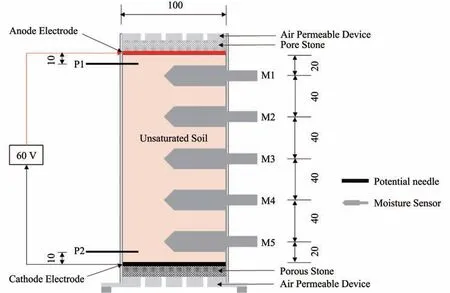
Figure 2 Custom-made apparatus for one-dimensional electroosmosis test on unsaturated soil(length unit:mm)
Figure 5 compares the drainage development ver‐sus time between the model simulation and laborato‐ry experiment.It should be noted that the drainage of both was calculated according to moisture content change and was not measured directly.It can be seen from Figure 5 that the drainage from the experiment increased linearly at the first 30 hours,then rose slowly between the 30th hour to 75th hour,and final‐ly stabilized.The drainage at the first 30 hours ac‐counted for 68.3%of the total,while the drainage be‐tween the 30th hour to 75th hour only comprised 26.6%.This indicates that the drainage induced by electroosmosis in unsaturated clay would be mostly completed at an early stage,which could help deter‐mine the duration in practical engineering to avoid energy waste.In contrast,the drainage from the mod‐el simulation increased linearly and quickly at the first 20 hours,then rose slowly till the end.The trend was almost a power function with time.The water discharge from the model simulation was 268.4 mL,which compares favorably with 255.1 mL from the experiment.
In general,the moisture content change of elec‐troosmosis in unsaturated compacted clay could be predicted by the proposed model.Next,the impact of different factors on the behavior of electroosmo‐sis in unsaturated soils is analyzed with this model.
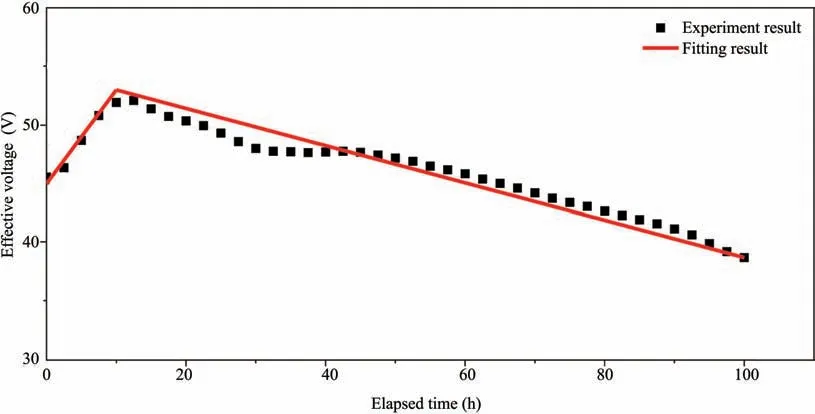
Figure 3 Effective voltage versus time recorded during the electroosmosis experiment
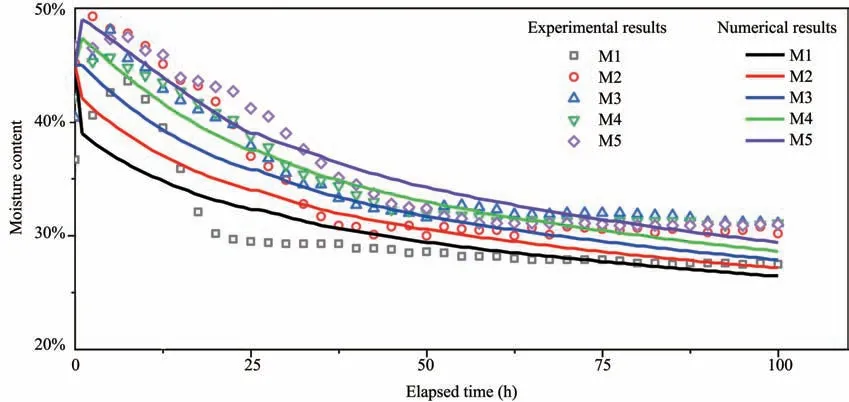
Figure 4 Comparison of moisture content versus time between the numerical simulation and experiment

Figure 5 Comparison of the drainage between the model simulation and experiment
4 Parametric analysis
Most parameters above are not constant but vary with moisture content during electroosmosis of unsat‐urated soil.The relationships between these parame‐ters and moisture content depend on soil properties.Soil-water characteristic curve parameters,including pore size distribution coefficientn,reciprocal of air entry valueα,have significant impacts on matric suc‐tion and hydraulic permeability,thus also influence electroosmosis-induced drainage.Pore size distribu‐tion coefficientnand air entry valueαare constant for a given soil.Tinjum(1997)tested three clay soils,found that pore size distribution coefficientnis 1.063 to 1.083 andαis 0.014 to 0.033.Fenget al.(2017)tested clay soils with different initial moisture con‐tent,found thatnvaried from 2.033 to 3.854 andαfrom 0.106 to 0.408.Therefore,a parametric analysis was carried out by assumingnto be 2.2,5,or 10,andαto be 0.01,0.03,or 0.05.Besides,the voltage value certainly affects electroosmosis.More precisely,the impact of the effective voltage,instead of the applied voltage,should be analyzed because of the remark‐able voltage drop occurring during electroosmosis.The effective voltage in the experiment was 20 to 50 V,and,therefore,the values of 10,30,and 40 V are considered in this analysis.A summary of the vari‐ous parameters and their values isprovided in Table 3.

Table 3 Parameter analysis of electroosmosis in unsaturated clay
4.1 Effects of n
Figure 6 shows moisture content change and drainage development versus time for different val‐ues ofn(n=2.2,5,and 10)withα=0.03,Ue=30.As shown in Figures 6a,6b,6c,the value ofnhas a sig‐nificant influence on moisture content change.The greater the value ofn,the faster moisture content decreases,and the lower the final moisture content is.The final moisture contents at M 1'through M5'forn=2.2,5,and 10 are 31.2%-35.4%,29.2%-32.0%,and 26.5%-29.4%,respectively.The final average moisture content is 33.3%forn=2.2,while those forn=5 and 10 are 30.6%and 27.9%,respec‐tively.The moisture content change indicates that electroosmosis is more suitable for soil with a larg‐er pore size distribution coefficient,which is con‐firmed by the drainage development shown in Fig‐ure 6d.It can be seen from Figure 6d that drainage increases faster,and the water discharge is greater when the value ofnincreases from 2.2 to 5,then to 10.The water discharge volumes forn=2.2,5,and 10 are 183.0 mL,226.1 mL,and 268.2 mL,respec‐tively.The growth rates of water discharge are 23.6%and 46.6%whennincreases from 2.2 to 5 and 10,respectively.
The larger the pore size distribution coefficient is,the better the electroosmosis effect is.According to the soil and water characteristic curve,unsaturated soil with a larger pore size distribution coefficient has less matric suction under the same saturation.There‐fore,the free water can migrate easily under electroos‐mosis.Drainage rate increases with an increasing pore size distribution coefficient.Secondly,soil with a larger pore size distribution coefficient has more void to store more free water,so its total water dis‐charge is higher.This finding demonstrates that elec‐troosmosis can achieve a better effect on loose soils.And the effect of electroosmosis on unsaturated soil could be preliminarily determined by the pore size distribution of soil.
4.2 Effects ofα
Figure 7 shows moisture content change and drainage development versus time for different values ofα(α=0.01,0.03,and 0.05)withn=2.2,Ue=30.As shown in Figures 7a,7b,7c,the effect ofαon mois‐ture migration is noticeable.The greater the value ofα,the faster moisture content decreases,and the lower final moisture content is.The final moisture contents at M1'through M5'forα=0.01,0.03,and 0.05 range in 37.2%-39.2%,31.3%-35.4%,and 28.3%-33.8%,respectively.
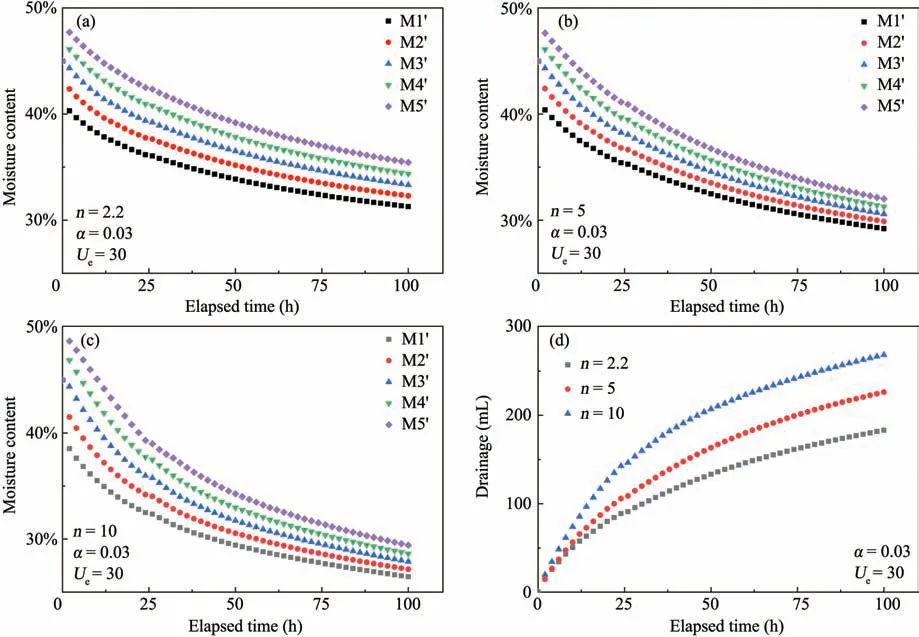
Figure 6 Moisture content change and drainage development versus time for different values of n
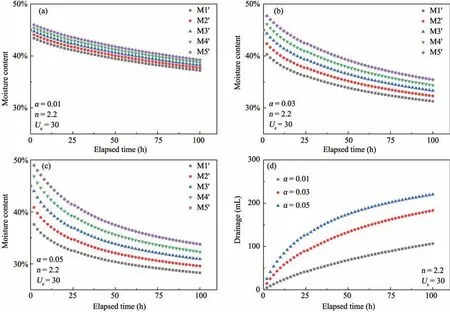
Figure 7 Moisture content change and drainage development versus time for different values ofα
The final average moisture content is 38.2%forα=0.01,while those forα=0.03,α=0.05 are 33.3%and 31.0%,respectively.The increase ofαpromotes moisture migration and leads to an increase of mois‐ture content difference between layers.The standard deviations of moisture contents at M1'through M5'forα=0.01,0.03,0.05 are 0.80,1.64,and 2.17,re‐spectively,which means that the non-uniformity of moisture distribution after electroosmosis would in‐crease with an increasingα.It can be seen from Fig‐ure 7d that the drainage velocity becomes faster,and the water discharge volume increases when the value ofαrises from 0.01 to 0.03,then to 0.05.The water discharge volumes forα=0.01,0.03,and 0.05 are 106.6 mL,183.0 mL,and 220.1 mL,respectively.The growth rate in water discharge whenαincreases from 0.01 to 0.03 is 71.7%,which is much larger than whenαincreases from 0.03 to 0.05,i.e.,20.2%.This funding shows that the efficiency of electroos‐mosis on unsaturated soil with largerαwould be un‐satisfactory.
The larger the reciprocal of air entry value is,the better the electroosmosis effect is.The soil with a larg‐er reciprocal of air entry value has a smaller intake pressure value,according to Van Genuchten(1980),which leads to an earlier start of drainage.The drain‐age of soils with largerαdecreases rapidly at the be‐ginning.Due to the lower matric suction,the drainage of soils with largerαis always easier,and moisture content decreases faster.Therefore,the effect of elec‐troosmosis on unsaturated soil also could be predicted by the air entry value of soil.
4.3 Effects of Ue
Figure 8 show Moisture content change and drain‐age development versus time for different values of Ue(Ue=10,30,and 40)with n=2.2,α=0.03.As shown in Figures 8a,8b,8c,the value of Uehas a remarkable impact on moisture migration.The increase in Uedefi‐nitely would accelerate moisture migration and in‐duce larger drainage in electroosmosis,as implied by the numerical results shown in Figure 8.Figure 8 shows that the final moisture contents at M1'through M5'for Ue=10,30,and 40 range within 37.1%-39.1%,31.3%-35.4%,and 29.5%-34.3%,respec‐tively.The final average moisture content decreases from 38.1%to 33.1%,then to 31.9%,when Uein‐creases from 10 to 30,then to 40,with the moisture content gap between different layers widened.And the water discharge volumes for Ue=10,30,and 40 are 110.7 mL,183.0 mL,207.2 mL,respectively,indi‐cating that the effect of increasing voltage diminishes when the voltage reaches a certain level.It is notewor‐thy that the effective voltage Ueusually is not constant but decreases with elapsed time because of the in‐creasing interfacial resistance at the soil-electrode in‐terface in practical engineering.The drop in effective voltage should not be ignored,and it would increase with increasing applied voltage.So it is more econom‐ical to adopt a suitable voltage and ensure its stability by improving soil-electrode contact.
5 Discussions
5.1 Effects of m2
Parameter m2dominates the relationship between electroosmotic permeability of unsaturated soil and moisture content,and its effect on electroosmotic permeability is similar to that of pore size distribu‐tion coefficient n on hydraulic permeability.It has a decisive influence on the electroosmosis of unsatu‐rated soil.It is important to choose a proper value of m2to determine the nonlinear behavior of unsaturat‐ed soil under electroosmosis.Therefore,further nu‐merical simulations were performed with different values of m2.Electroosmotic permeability was found to be less sensitive to moisture content than hydrau‐lic permeability according to Gabrieli et al.(2008),so the value of m2was varied at 0.3,0.4,and 0.5,while other parameters were fixed as follows:n=2.2,α=2.2,Ue=30,Kes=6×10-7m/s,Khs=5×10-7m/s,θs=0.5,θr=0.03.Figure 9 shows moisture content change and drainage development versus time for different values of m2.As shown in Figure 9,the dif‐ferences in the moisture migration and drainage are noticeable for different m2values,final average mois‐ture content decreases from 37.9%to 33.3%,and to 29.5%,and water discharge volume increases from 111.7 mL to 183.0 mL,and 244.6 mL when m2rises from 0.3 to 0.4,and 0.5.These results demonstrate that small variations in m2values may cause large dif‐ferences in numerical prediction results,indicating that the electroosmotic characteristic of unsaturated soil is key to the efficiency of electroosmosis.
Figure 10 shows the moisture distribution along the height and average saturation after electroosmo‐sis for different values of m2.It can be seen from Figure 10a that moisture contents of different layers all increase from top to bottom for different values of m2,which means that the effects of electroosmo‐sis become worse from the anode to the cathode.Moisture contents of different layers all decrease with an increasing m2,but their gap increases.This result is consistent with the previous conclusion that electroosmosis would result in serious nonuni‐form moisture distribution in unsaturated soil.Fig‐ure 10b shows that average saturation degrees after electroosmosis for m2=0.3,0.4,and 0.5 are 75.8%,66.7%,and 58.9%,respectively,and decrease with an increasing m2.

Figure 8 Moisture content change and drainage development versus time for different values of U e

Figure 9 Moisture content change and drainage development versus time for different values of m2
This shows that electroosmosis can reduce the saturation of unsaturated soil to a certain extent but not to the optimum saturation degree of 48.2%.The rapid increase of resistance in the upper drier soil consumes most of the effective voltage,resulting in a sharp decrease in the efficiency of electroosmosis.It is crucial to increase the electroosmotic permea‐bility of unsaturated soil with low moisture content to improve the effectiveness of electroosmosis on saturated soil.
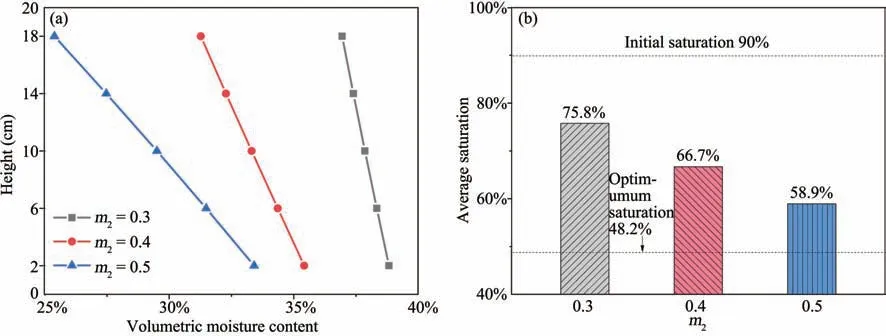
Figure 10 Moisture distribution and average saturation after electroosmosisfor different values of m2
5.2 Method to mitigate nonuniform moisture distribution
It is also found that the electroosmosis could induce nonuniform moisture distribution,with the soil mois‐ture content decreasing from top to bottom.The mois‐ture content difference between the top and bottom lay‐ers could be up to about 10%,which would cause un‐even soil properties.In theory,the soil permeability can‐not be altered artificially,so the only method to mitigate nonuniform moisture distribution is to supply a suitable voltage.This implies that one should choose the proper voltage according to the soil's natural properties and se‐lect electrodes with excellent durability and good con‐tact with the soil to ensure a stable effective voltage.
6 Conclusions
In this study,a one-dimensional model of mois‐ture migration in unsaturated soil under electroosmo‐sis was proposed based on fluid mass conservation,electroosmotic flow equation,Richard's law,and charge conservation.The numerical model simulated results of moisture migration and drainage were com‐pared with experimental results,and parametric analy‐ses were conducted to evaluate the effects of the soilwater characteristic relationship.Based on the find‐ings from this study,the following conclusions can be drawn as follows:
(1)The model-simulated results agree well with experimental ones in terms of moisture content and drainage variations with time,which indicates that the numerical model proposed in this study could capture the nonlinear behavior of moisture migration in unsat‐urated soil under electroosmosis.
(2)Pore size distribution and air entry value of un‐saturated soil both have significant effects on mois‐ture migration of unsaturated soil under electroosmo‐sis.Moisture migration is more obvious in unsaturat‐ed soils with larger pore size distribution coefficients and smaller reciprocal of air entry value.The effects of electroosmosis on drainage could be determined by pore size distribution and air entry value.
(3)Increasing effective voltage can significantly promote electroosmosis-induced drainage in unsatu‐rated soils,but how to ensure a stable effective volt‐age remains a challenge in practical engineering.
(4)Electroosmosis can induce nonuniform mois‐ture distribution,resulting from the complex relation‐ship between the electroosmotic permeability and moisture content.It is more reasonable to evaluate the treatment effects of electroosmosis on unsaturated soil with moisture distribution instead of drainage.
Acknowledgments:
The authors greatly appreciated the financial support from the National Key Research and Development Program of China(No.2018YFC1505306),and the National Natural Science Foundation of China(No.41971076).
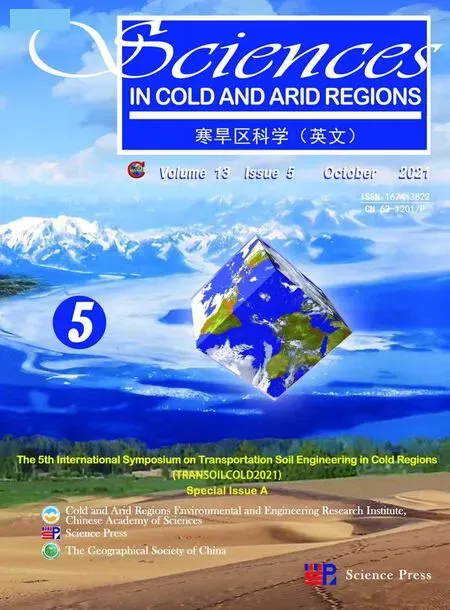 Sciences in Cold and Arid Regions2021年5期
Sciences in Cold and Arid Regions2021年5期
- Sciences in Cold and Arid Regions的其它文章
- Study on mechanical properties of soil-rock mixture of various compactness subjected to freeze-thaw cycles
- Strength characteristics and energy dissipation evolution of thawing silty clay during cyclic triaxial loading
- Impact of brine on physical properties of saline soils
- Study on thermal-state variation of high-grade highway embankment under different pavement conditions
- Field monitoring of differential frost heave in widened highway subgrade
- Study on tensile damage characteristicsof sandstone under freeze-thaw cycles
